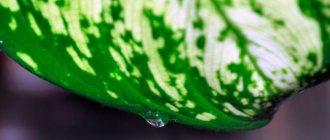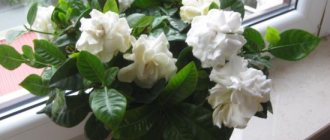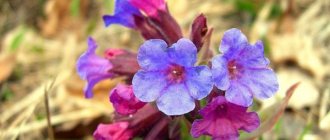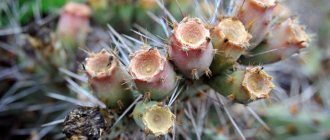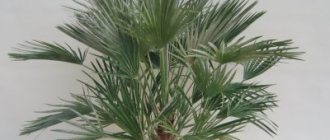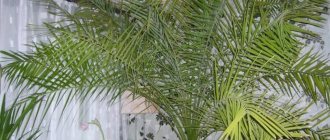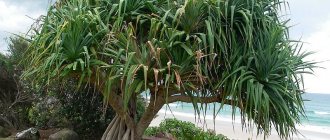Washingtonia is a chic palm that fits harmoniously into modern home and office interiors, especially if you need to profitably fill empty space. A beautiful decorative foliage plant with a spectacular fan-shaped crown brings into the room the special exoticism of overseas countries, involuntarily bringing to mind thoughts of long-distance travel and an unforgettable vacation. In addition, plants play not only the role of decoration, but also create favorable conditions for human life. And although Washingtonia is a resident of the subtropics, preferring a Mediterranean climate, if certain rules of care are followed, it feels great not only in greenhouses and winter gardens, but also in ordinary home conditions.
This is interesting! In its homeland, Washingtonia has long been used as a food crop, consuming berries and petioles in various forms, and baskets are woven from the leaves.
Botanical description
Washingtonia (lat. Washingtonia) is a palm tree named after George Washington (the first President of the United States). There are only two species of these palms - Washingtonia filamentosa and Washingtonia stouta, and the genus itself is part of the Arekova family. The Washingtonia palm is a tree that grows up to 25 m in height and almost 1 m in diameter. But this is in its natural habitat. Fan-shaped leaves grow at the top of the trunk. Petiole up to 1.5 m long, with spines directed towards the trunk. Washingtonia rarely blooms indoors. In the USA and Mexico, baskets are woven from the fibers of the leaves, and flour is made from the fruits. In Europe, this palm is cultivated on the southern coast of the Mediterranean. At home, Washingtonia needs space and coolness. When the plant reaches a significant size, it is better to take it outside, if, of course, weather conditions allow this.
Spectacular and beautiful composition
For those who want to get a beautiful composition at home, but do not want to spend a lot of time maintaining it, the Washingtonia palm tree, a decorative indoor plant, is perfect. In the wild, the genus is found in North America, or more precisely in the subtropical zones of this continent. It belongs to the Palm family. In culture, the plant is actively used as a decorative urban planting in Florida and California. In the wild, the plant mainly grows in groups in the lowlands of the subtropics, namely where there is access to groundwater.
In Florida there are plantings that differ significantly in growth from those in California. Botanists attribute this to climatic conditions. Florida experiences frequent thunderstorms during which lightning strikes trees that tower above the state's low vegetation.
In Russia, the plant is actively cultivated in Sochi, Crimea, and also in some parts of the Mediterranean. The Washingtonia palm does well in dry climates and is easy to grow as a houseplant. In this issue we will learn how to get a spectacular composition with your own efforts, growing it from seeds.
Briefly about cultivation
- Flowering: The palm tree is grown as an ornamental foliage plant.
- Lighting: bright diffused light for 16 hours a day. In winter, additional artificial lighting is required.
- Temperature: in spring and summer – 20-24 ºC, no more, in winter – about 10 ºC.
- Watering: in spring and summer - after the top layer of the substrate has dried, in winter watering is symbolic.
- Humidity: high. During the growing season, it is recommended to spray the leaves twice a day and wash them with a damp sponge weekly. It is advisable to place containers of water around the plant. In winter, Washingtonia is not sprayed.
- Feeding: from spring to autumn 2 times a month with fertilizers with an emphasis on iron. At other times, fertilizing is not necessary.
- Dormant period: from late autumn to early spring.
- Replanting: in the spring and only if necessary: up to 7 years - once every 2 years, up to 15 years - once every three years, and after - every 4-5 years.
- Substrate: four parts turf soil, two leaves, two parts humus or peat and one part sand.
- Reproduction: seed.
- Pests: scale insects, whiteflies, spider mites and mealybugs.
- Diseases: the roots can rot from improper watering or lack of drainage in the pot, and the tips of the leaves can dry out from low air humidity.
Read more about growing Washingtonia below.
Selecting a location
Lighting for Washingtonia should be natural - it loves bright diffused light, which can be provided by windows oriented to the southwest and southeast. If it is a veranda, then it must have winter heating.
In order for Washingtonia leaves to develop evenly, as it grows, it must be regularly turned towards the light source!
In hot weather, the plant should be protected from direct sunlight, moving it a little further from the window. In winter, on the contrary, make sure that the palm tree receives the optimal portion of light every day and does not suffer from sources of artificial heat.
If Washingtonia is constantly indoors, then it is useful for it to arrange air baths - take it out to the balcony for several hours or just outside. It is better to do this in late spring, when the air has already warmed up enough. Read about the date palm!
The optimal temperature for keeping Washingtonia ranges from +18-21°C. In this case, some deviations are possible, for example, in summer the maximum level should not exceed +24°C, and for successful wintering the plant requires lower values - about +10-18°C.
Caring for Washingtonia at home
Lighting
The main misconception is that the Washingtonia palm tree loves the sun. When growing Washingtonia, it does not need direct rays of the sun; it needs bright but diffused light for at least 16 hours a day. It is advisable to grow Washingtonia on western or eastern windowsills. In winter or simply when daylight hours are short, additional lighting (fluorescent) is needed for normal growth. In summer, it is advisable to take Washingtonia outside to a bright but shaded place and cover it from precipitation. The room needs to be ventilated, but do not place the tree in a draft. Washingtonias need a lot of light throughout the year.
Temperature
In summer and spring, temperatures should fluctuate around 20-24 °C. If the temperature tends to 30 °C, then the plant needs to be moved to a cooler room, allowed to cool, then watered and sprinkled. In winter, the temperature should be around 10 °C. Do not be afraid, in its homeland the Washingtonia palm tree tolerates frosts down to -7 °C.
Watering Washingtonia
The Washingtonia plant at home is afraid of both waterlogging and lack of moisture, so this palm tree needs to be watered immediately after the top layer of soil has dried out - this is in spring and summer. Since the temperature drops in autumn, the frequency and abundance of watering is reduced. In winter, the main task is to prevent the earthen coma from drying out completely, i.e. water two to three days after the substrate has dried from above. Before watering, the water is allowed to settle (for a day), and watered only with warm water.
- How to replant an orchid - step by step
Spraying
For the full development of Washingtonia, high air humidity is necessary, so in addition to daily spraying (preferably twice a day), it makes sense to place a container of water next to the pot. It is a good idea to occasionally wipe the leaves with a damp cloth.
Top dressing
Washingtonias at home need fertilizer for good growth. Best of all - with an emphasis on hardware. Feed in spring and autumn 2 times a month at equal intervals. The rest of the time, as well as immediately after transplantation or during illness, Washingtonia is not fertilized.
Trimming
It is advisable to trim Washingtonia leaves before they completely dry out - this slightly slows down the natural drying of the next leaves. If the leaves are not cut off when they are dry, then the dry leaves don’t need to be cut off anymore - they will hang beautifully around the trunk.
Washingtonia transplant
Washingtonia is transplanted only if it is really necessary, since after transplantation the palm tree needs time to “come to its senses” and growth slows down a little. Up to 7 years old, Washingtonia is replanted once every 2 years, from 8 to 15 years old - once every three years, and from 15 years old - every four years (possibly after 5 years). Transshipment or transplantation should be carried out before summer, preferably in early spring. Since the palm tree is not a small tree, they are grown in wooden tubs. The substrate is made up of either turf, leaf, humus soil and sand (4: 2: 2: 1), or in the same proportions, but instead of humus, add peat. It is advisable to feed adult specimens with organic fertilizers during transplantation - about 5 kg. As the roots become exposed on the surface, you need to add fresh substrate.
Growing from seeds
The Washingtonia palm tree reproduces by seeds in the spring – March-April. Anyone who wants to achieve success with the highest probability will use only fresh seeds. The older the seeds, the lower the chance of germination and the longer the time. Before planting, the seeds need to be filed (lightly) and soaked in water for 24 hours. The seeds are deepened 1 cm into a substrate made of equal parts of moss, sand and sawdust, with the addition of crushed charcoal. The sawdust must be steamed before preparing the substrate. After planting, water the soil, cover the container with glass and place it in a warm place, maintaining the temperature at 28-30 °C. If the seeds are fresh and the care is correct, the seedlings will appear within two to three weeks. When the first leaf appears on the sprout, count the week and plant the seedling in a container with a mixture of 2 parts turf soil and one part each of leaf soil and sand. Do not worry that the leaves are not cut - the cuts will appear on the 8-9th leaf. After a year of your efforts, the Washingtonia indoor plant will already have four to five leaves. You need to pick the plant very carefully! This is how Washingtonia is grown from seeds.
Features of growing from seeds
Adult palm trees occasionally produce white bisexual flowers, collected in paniculate inflorescences, arched downwards. The fruit is an oblong black drupe with pulp and oval seeds.
Usually, flower shops sell young specimens in pots, but if desired, Washingtonia can be grown from seeds at home. Although it should immediately be noted that this process is long and labor-intensive. In addition, the seeds are characterized by low germination and take a long time to germinate. You need to take only fresh and ripe seed material, and it is better to sow it in the spring.
A light substrate that allows water and air to pass through well is sterilized in the oven (30-60 minutes at 200°C) or microwave (10 minutes at full power). To prevent fungal diseases, the soil can be shed with a fungicide solution.
The container is filled with prepared substrate, to which peat or sphagnum can be added. Seeds, pre-soaked for at least a day in warm water (37-40°C) or in a solution of a biogrowth stimulator, are scattered on the surface and sprinkled with a 0.5-1 cm layer of soil. Spray from a spray bottle and cover with glass or polyethylene. The temperature for successful germination should be about 25°C. Bottom heating using special electric mats or other suitable devices is desirable. It is also necessary to maintain optimal humidity.
Shoots should appear in 2-3 weeks. When the first leaf, several long roots grow, and the seedlings grow up to 10 cm, they are planted in individual pots. During the year, 3-5 true leaves are formed, and the dissection of the plate into segments occurs in the 2nd year of life. Under favorable conditions, plants grow quickly and actively.
Diseases and pests
The roots of Washingtonia are rotting. This problem occurs due to too frequent watering - the soil does not have time to dry out. The pot may have poor drainage and excess water is not draining out of the pot.
- How to replant an orchid - step by step
Washingtoni leaves are falling. Washingtonia requires high air humidity, and if the air is too dry, Washingtonia begins to shed its leaves.
The tips of Washingtonia leaves turn brown. This is the second problem caused by too low air humidity - spray Washingtonia more often and place a container of water next to it.
Washingtonia pests. Most often, Washingtonia is affected by scale insects, whiteflies, spider mites and mealybugs.
Watering
One of the worst enemies of Washingtonia is a dry substrate, so it is necessary to constantly monitor its condition and water the plant on time: in the summer, generously a couple of times a week, in the winter, when it is at rest, sparingly, once every 10-14 days.
In winter, the soil should be barely moist!
Do not forget that excessive watering, just like drying out the soil, can have a detrimental effect on the health of the plant. If the substrate is over-moistened, the root system may rot, which will subsequently lead to drying out of the leaves.
In addition, when watering Washingtonia, it is important to take into account the size of the tub and the air humidity in the room. For optimal plant growth and development, humidity should be between 55 and 75%. However, if in summer it is quite simple to ensure this condition - by opening the windows, then in winter, when the heating system is operating, the air should be humidified artificially. For this, a spray bottle is usually used, spraying both the plant itself and the soil surface. If such a measure seems inconvenient for you, then you can install a household humidifier. In winter, it is recommended to additionally wash the leaves with clean water at room temperature. You just need to do this carefully so as not to hurt your hands on the thorns.
The basic rules for watering are as follows:
- a young plant, unlike an adult and an old one, does not need abundant watering and moisture;
- never place a container of water under the pot - the soil always absorbs a lot of moisture, which is unacceptable for Washingtonia;
- For irrigation, it is advisable to use soft water - it can be bottled or infused rainwater.
Kinds
Washingtonia filamentous (filamentous) / Washingtonia filifera
Lives in the southern part of the USA. Under natural conditions it grows up to 20 m in height. The trunk is smooth and straight. At the top there are fan-shaped leaves that are green with a slight shade of gray. Leaves up to 2 m in length, dissected into thirds, form up to 80 lobes. There are long white threads on the edges of the leaves. Rarely blooms indoors. The flowers are white.
Washingtonia robusta (robusta) / (Washingtonia robusta)
Also known as Washingtonia sonorae . This species is a tree-like perennial that grows in nature up to 30 m in height. The leaves are fan-shaped and light green in color. In this species, the leaves are cut deeper - 2/3 of the leaf length. The petiole has a reddish tint. Blooms with white flowers.
Washingtonia filamentous or filamentous (Washingtonia filifera)
There are only two species in the genus, which are not very different from each other. Both representatives can be grown indoors if you know what their most important difference is - the temperature regime. First of all, let's talk about a more cold-resistant species, Washingtonia filamentosa; it is a perennial palm tree up to 25 meters high. The trunk has a cylindrical shape. Its diameter is up to 80 cm. The gray surface is covered with interspersed leaf petioles, which is why it can have a ribbed structure.
Towards the top, the trunk of filamentous Washingtonia gradually narrows and bears a rosette of fan-shaped leaf plates. The leaves of the plant reach 3-4 meters. The leaf blade is pinnately dissected into 70-90 pieces. The middle part is represented by xiphoid segments, up to 1.5 meters long and up to 6 cm wide. The extreme part is smaller in length (up to 80 cm) and width (up to 1 cm). The entire leaf blade has white threads that hang along the edges of the fan leaves.
The leaves of Washingtonia filifera are attached to the trunk by large woody petioles. On their lower surface there are sharp, spine-like teeth of a yellowish color with a bent tip towards the shoot of the palm tree. During the period of active growth, which lasts from early May to autumn, up to 13 leaves are formed, which have a lifespan of 2-4 years.
The flowers of filamentous Washingtonia are collected in long paniculate inflorescences, reaching from 3 to 5-6 meters in length. They are bent in an arc towards the surface of the trunk. After flowering, fruits are formed - oblong drupes with a fleshy surface and seeds.
Popular varieties and types of exotic palm trees
Usually in our apartments you can find the two most popular types of indoor palm trees.
Washingtonia filamentosa (filamentous)
Its homeland is California, so the plant has another name - California fan palm. In places where it grows naturally, it creates entire forests. The leaves of this tree have a gray-green tint and many fine white threads. For a comfortable wintering of thread-bearing Washingtonia, it is necessary to provide an air temperature of 6-15 ° C plus a well-lit place.
Washingtonia robusta (potent)
The tree was born on the shores of Mexico, so it is not surprising that it is also called the Mexican palm. Mature plants have a taller trunk than Californian relatives and can reach thirty meters in height. The foliage of Washingtonia is powerful, rich green, but without snow-white threads. The leaf petioles have thorns, and the crown itself is located at the top of the trunk and looks very compact. Wintering of this species does not require special conditions and can be carried out in the indoor mode familiar to the owners.
Types of livistons with photos and names
Below we will describe those types of Liviston palm trees that gardeners most often grow at home.
Chinese Livistona (Livistona chinensis)
The palm reaches a height of 10 to 12 meters, and the diameter of its trunk is 0.4–0.5 meters. She is originally from Southern China. The surface of the upper part of the trunk is covered with the remains of dead petioles of leaf plates and fibers. And the lower part of the trunk has a serrated surface. The fan-like drooping leaf blades include from 50 to 80 folded segments, which are deeply incised at the tips. The leaves have wide petioles, the length of which can reach up to 150 cm; on their lower surface there are many straight, short and rather sharp spines. The length of the axillary inflorescence often exceeds 100 cm.
Livistona rotundifolia
Or Liviston rotundifolia. In nature, this species can be found on the coastal sandy soils of the Moluccas and Java. The height of the trunk is up to 14 meters, and in diameter it reaches about 17 centimeters. Green glossy fan-shaped leaf plates of round shape reach about 150 cm in diameter, and at 2/3 of the length they are cut into folded segments. The foliage has long (up to 150 cm) petioles, which in the lower 1/3 part are densely strewn with thorns. The length of the axillary inflorescence is about 150 cm, it consists of yellow flowers. Since this species is most popular among gardeners, this article described how to care for it.
Southern Livistona (Livistona australis)
This species is native to the subtropical rainforests of eastern Australia. The height of the columnar trunk of this palm tree is about 25 meters, while its diameter reaches up to 0.4 m. At the base, the trunk is thickened and its surface is covered with scars, as well as the remains of leaf sheaths. The folded, radially fan-shaped leaves are divided into small lobes with double-cut ends. These glossy dark green leaf blades have long (about 200 cm) petioles, along the edges of which sharp spines are densely arranged, almost brown in color. The length of the axillary branched inflorescence is about 1.3 m.
Livistona decipiens
This single-trunk palm tree is characterized by slow growth, and it reaches a height of about 12 meters, with a trunk diameter of up to 25 centimeters. The leaf blades are fan-shaped; they are cut into drooping segments in numerous veins. Their front surface is dark green, and their back surface is grayish-waxy. There are many small teeth on the leaf petioles.
Livistona mariae
Under natural conditions, this large palm tree can reach a height of about 30 meters. At the base, the gray trunk has a thickening, and its surface is covered with the remains of leaf sheaths. The length of the fan-shaped leaf blades, as well as their petioles, is about 200 centimeters; they are divided into drooping lobes of a linear shape, and at a young age they have a reddish-pink color. As the lobes grow and develop, they become reddish-bronze and eventually turn green-blue. Simple panicles consist of cream or yellowish flowers. The glossy, spherical fruits are black in color and reach about 20 mm in diameter.
In addition to the species described above, Easton's livistona, beautiful and other species are also grown at home, which are still poorly studied today.
How to grow Livistona
Watch this video on YouTube
Planting a Washingtonia palm
For mature plants, tall pots will be needed, but for young palm trees they are not necessary.
Washingtonia has poorly developed fibrous roots, and the main root develops very long and makes several turns inside the pot. Its bulk is concentrated below, near the drainage layer. Over time, this root becomes lignified and, if the root system is handled carelessly during transplantation, it easily breaks and dies
Like most domestic palm trees, representatives of this genus are sensitive to transplantation. Their owners try to resort to radical intervention in the root system only in very extreme cases - if there is a suspicion of disease or pest damage.
Young seedlings are replanted in the spring as they develop, middle-aged plants - once every 2-3 years. For large-sized plants growing in tubs, only the top layer of the earthen ball, 5–10 cm thick, is changed
Loosen it carefully with a wooden stick so as not to touch the roots, remove it with the palm of a rubber glove and fill it with a new substrate.
Very often, the root system is exposed in the area of the root collar, which indicates that the pot for the palm tree has become cramped. However, there is no need to rush into transplantation work if the time is not right for it. It is enough to mulch the exposed roots with wet sphagnum, and then during watering, after the moss has dried, lift it, watering only the substrate between the roots, and leaving the sphagnum dry.
Flower growers who have bought Washingtonia in a flower shop often ask whether it is necessary to replant the plant immediately after purchase? It is desirable, since the pots with which the plant is sold contain a large proportion of peat, and the palm tree feels uncomfortable in it.
The soil mixture for growing Washingtonia is quite suitable, but the purchased one “For palm trees” is quite suitable, but it is absolutely possible to make it yourself. It is enough to take 2 parts of turf soil and 1 part each of humus, peat, leaf soil and sand. For very large specimens, the amount of turf component is doubled. A good drainage layer at the bottom, usually consisting of expanded clay with the addition of a small amount of pieces of birch charcoal, is important.
Common problems when growing indoor palm trees
When keeping palm plants indoors, you can sometimes encounter a number of difficulties and problems:
- Root and trunk rotting. The reason for this phenomenon is severe waterlogging of the soil combined with low temperatures. Treatment is possible only in the early stages, by replanting with pruning of rotten areas of the root system. If rot has spread to the trunk, treatment is futile.
- Penicillosis. A fungal infection that attacks young growing leaves and then penetrates the growing point. It develops with a lack of light, low temperatures and water on the apical bud. Treatment in the early stages is by treatment with a systemic fungicide. You can spray with Ridomil Gold.
- Infectious spots. They appear as red-brown or yellow spots on the leaves. They are treated by treating with fungicidal preparations (Topsin, Ridomil Gold).
- Browning of leaves. A process caused by waterlogging of the soil and watering with cold water. The plant is dried or transplanted into a less moisture-intensive substrate. The affected leaves are allowed to dry and cut off using dry cloth.
- Sunburn. They appear on the leaves of shade-tolerant palm species when placed in bright sun. Depending on the extent of the damage, the leaves may retain their function or lose it completely. A burn at the top is especially dangerous, leading to the complete death of the plant.
Pests rarely settle on palm trees, but sometimes you can encounter an infestation with mealybugs, spider mites, thrips or scale insects. Treatment is carried out only with special chemical insecticides and acaricides.
To prevent diseases of palm plants, it is important to follow the recommended growing conditions. Infectious and other lesions develop on specimens with weak immunity, which are maintained incorrectly, in violation of agricultural practices
Caring for a palm tree indoors
This is not to say that caring for Washingtonia requires a lot of time and effort.
However, like all ornamental pets, the palm tree “demands” attention. Caring for the plant comes down to compliance with the following conditions:
Location, lighting
Both the filamentous palm and the robusta palm, Washingtonia prefer strong sunlight, but not direct rays. It is advisable to allocate the brightest places in the room for Washingtonia. In summer, it is advisable to take the palm tree outside from the room - to the courtyard, balcony or loggia.
A convenient optimal air temperature in summer is 18-25 0 C. In winter, 12-15 0 C is enough for the plant. Washingtonia needs to be located in a well-lit place in winter.
When choosing a place of residence for Washingtonia, they monitor the possibility of ventilation, but avoid drafts.
Irrigation, air humidity
The plant needs stable watering, but seasonality should be taken into account. In summer, at high outside temperatures, if the plant “lives” outside, water it once every 6-8 days, but this is, of course, conditional. The heat may vary, and you need to monitor the moisture content of the soil in the pot.
In winter, watering is reduced, and each subsequent watering is done only after the soil in the pot has completely dried. In winter, the plant is in a state of rest, but it should not be allowed to dry out.
Air humidity in the room is not lower than 55 and not higher than 75 percent. To maintain humidity, use a sprayer. During the cold season, it is useful to wash the leaves with warm water or wipe with a damp cloth.
Washingtonia Robuts flowers and Santa Barbara variety
The second type is Washingtonia Robutsa or Strong. This one is not much different from the previous copy. Washingtonia flowers are the same perennial palm tree, up to 20-25 meters high. Together with the leaves, it forms a plant with a diameter of 50 to 100 cm. The leaf blades look like fans, as they are cut into numerous segments (up to 70 pieces on one petiole). The middle part of the leaf is prominent: cut into sections up to 1.5 meters long and up to 6 cm wide. The outer parts are up to 50-60 cm long and up to 1.5-2 cm wide. Unlike the thread-like petiole of Robutsa, it is completely covered with sharp spines. Leaf blades are formed all year round, but the bulk are formed during the active life cycle (spring and summer). Up to 15 new plates appear per year, which live up to 3 years.
Robusta or the Santa Barbara variety blooms only in wild conditions with long daylight hours. At this time, white flowers are formed in large paniculate inflorescences up to 3 meters drooping and bent in an arc. Flowering lasts about a month, less often up to 40 days. Afterwards, it forms a fruit - a black drupe. Mexico is considered to be its homeland; in this part the plant grows in large groups. Botanists and flower growers, in contrast to the filamentous species, consider this one less resistant to cold (tolerates a short-term drop in temperature to 7 degrees below zero).


